Rakuten Bundle
How Does Rakuten Thrive in the Digital World?
Rakuten, a global powerhouse originating from Tokyo, Japan, has carved a significant niche across the internet landscape. From its humble beginnings as an e-commerce platform, Rakuten has evolved into a multifaceted corporation. In fiscal year 2024, the company achieved a record-breaking revenue, demonstrating its robust financial health and market dominance.
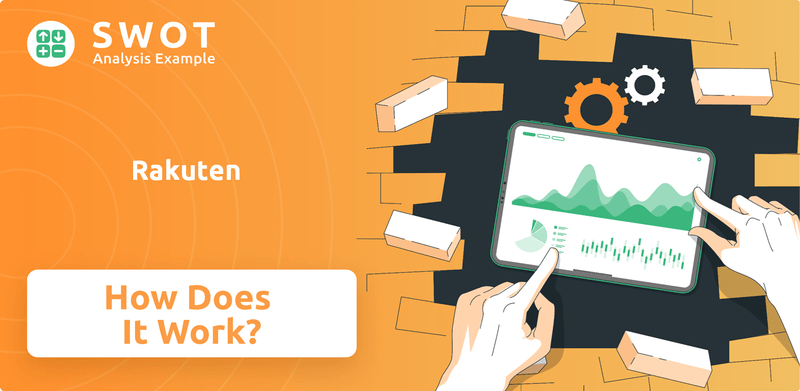
To truly grasp the scope of Rakuten SWOT Analysis, one must understand its core operations and how it generates revenue. This deep dive will explore How Rakuten works, from its e-commerce roots to its expansive Rakuten ecosystem, including Rakuten services like fintech and digital content. This analysis is crucial for anyone seeking to understand Rakuten company's strategic moves, competitive advantages, and future outlook. Understanding the Rakuten business model is key to evaluating its continued growth.
What Are the Key Operations Driving Rakuten’s Success?
The Rakuten company operates through a multifaceted ecosystem designed to deliver a wide array of internet services. Its core operations are structured around three main segments: Internet Services, FinTech, and Mobile. This integrated approach allows Rakuten to offer a diverse range of products and services, fostering customer loyalty and driving cross-platform engagement.
At the heart of How Rakuten works is its e-commerce platform, Rakuten Ichiba, which differentiates itself through a focus on care, detail, and personal interaction. This strategy supports a robust merchant community and a wide selection of products. The FinTech segment provides a suite of financial services, including credit cards, banking, and securities, which are deeply integrated into the Rakuten ecosystem. The Mobile segment, while initially incurring losses, is focused on achieving profitability.
The value proposition of Rakuten lies in its integrated ecosystem, which promotes cross-use of services and enhances customer loyalty through its powerful points-based loyalty system, Rakuten Super Points. These points can be earned and spent across more than 70 services, effectively functioning as real currency within the ecosystem. This deep integration and loyalty program foster user stickiness, with over 70% of users interacting with multiple Rakuten services.
The Internet Services segment includes Rakuten Ichiba, travel booking sites, digital content sites, and professional sports team management. Rakuten Ichiba emphasizes care and personal interaction, fostering a strong merchant community. This segment is crucial for driving overall ecosystem engagement and providing a diverse range of offerings.
The FinTech segment offers a comprehensive suite of financial services. This includes credit cards (Rakuten Card), banking (Rakuten Bank), and securities (Rakuten Securities). These services are deeply integrated into the Rakuten ecosystem, providing seamless payment and loyalty point accumulation. Rakuten Bank reached 16.83 million customer accounts as of March 2025.
The Mobile segment, Rakuten Mobile, focuses on communication services and technologies. Despite initial heavy investments, Rakuten Mobile aims for full-year EBITDA profitability in FY2025. As of March 2025, Rakuten Mobile's total subscriptions reached 8.63 million. This segment is a key component of Rakuten's integrated ecosystem.
Rakuten Super Points are a central part of the Rakuten business model, functioning as a loyalty program. Points can be earned and spent across more than 70 services, encouraging cross-platform usage. This system enhances customer loyalty and drives user engagement. The loyalty program is a key factor in user retention.
Rakuten's operational processes include technology development, robust logistics for e-commerce, diverse sales channels, and comprehensive customer service. These processes are essential for supporting its wide range of services and maintaining a competitive edge. The company's focus on innovation and customer satisfaction is evident in its operational strategies.
- Advanced Technology Development: Continuous innovation in e-commerce, FinTech, and mobile technologies.
- Robust Logistics: Efficient fulfillment and delivery systems for e-commerce.
- Diverse Sales Channels: Multiple channels to reach customers, including online and mobile platforms.
- Comprehensive Customer Service: Providing support across all services to enhance user experience.
To understand the bigger picture, consider exploring the Growth Strategy of Rakuten. This detailed analysis provides further insights into Rakuten's e-commerce strategy, its global presence, and how it competes with other major players.
Rakuten SWOT Analysis
- Complete SWOT Breakdown
- Fully Customizable
- Editable in Excel & Word
- Professional Formatting
- Investor-Ready Format
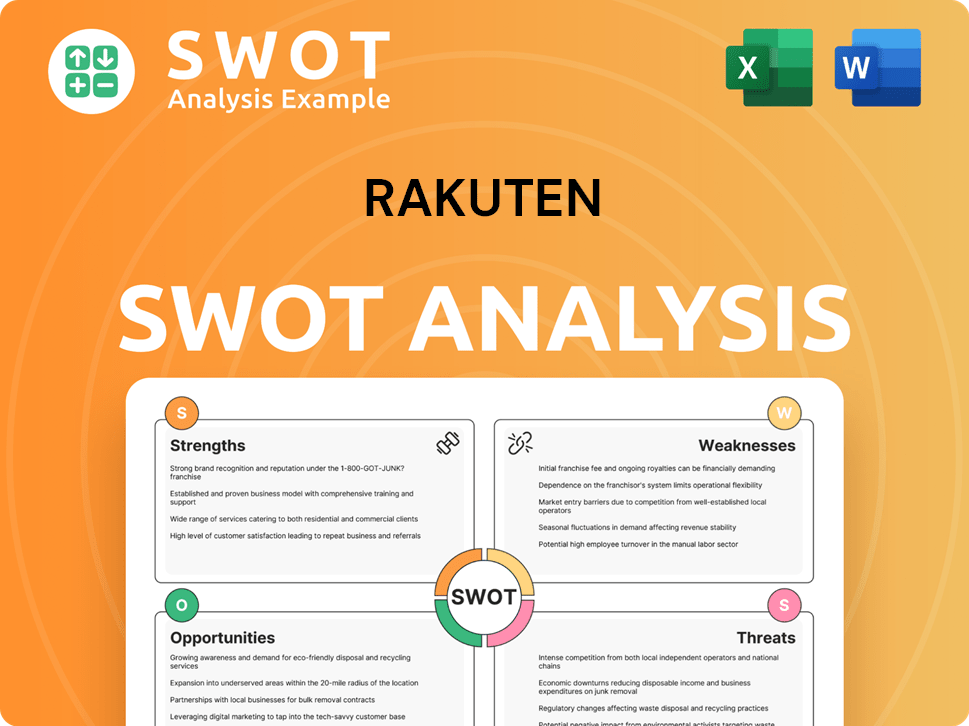
How Does Rakuten Make Money?
The Rakuten company employs a diversified revenue model, primarily generating income through its Internet Services, FinTech, and Mobile segments. This strategy has proven successful, with Rakuten achieving record-high consolidated revenue in recent fiscal periods. The company's ability to monetize various services across its ecosystem showcases its robust business model.
Rakuten's financial performance highlights its strong market position and effective monetization strategies. The company's focus on expanding its services and enhancing customer engagement through its loyalty program, Rakuten Super Points, further drives revenue growth. This integrated approach allows Rakuten to capture value across multiple sectors, ensuring a resilient financial outlook.
For the fiscal year 2024, Rakuten's consolidated revenue reached a record high of 2.3 trillion yen, a 10% increase year-on-year. In Q1 FY2025, consolidated revenue continued its upward trend, reaching 562.7 billion yen, up 9.6% year-on-year, a record high for the first quarter.
The Internet Services segment is a core component of Rakuten's revenue generation. It includes e-commerce, advertising, travel booking, and digital content sales. This segment benefits from strong domestic e-commerce sales and strategic partnerships.
- In Q1 FY2025, this segment generated 305.5 billion yen in revenue, reflecting a 6.9% year-on-year increase.
- Domestic e-commerce gross merchandise sales (GMS) in Q1 FY2025 reached 1.4 trillion yen, up 3.0% year-on-year.
The FinTech segment is a significant revenue driver for Rakuten, encompassing credit card services, banking, securities trading, and payment services. This segment's growth is fueled by increased adoption of its financial products and services.
- The FinTech segment recorded 223.6 billion yen in revenue in Q1 FY2025, a substantial 15.6% increase year-on-year.
- Rakuten Card's shopping gross transaction value reached 6.3 trillion yen in Q1 FY2025.
- Rakuten Bank's customer accounts reached 16.83 million as of March 2025, and Rakuten Securities' general securities accounts exceeded 12.34 million.
- In FY2024, the FinTech segment's revenue was 820.4 billion yen, up 13.1% year-on-year.
The Mobile segment focuses on mobile subscriptions and data usage, with Rakuten aiming for profitability. The segment's revenue growth is supported by subscriber acquisition and efficient operational strategies.
- The Mobile segment recorded revenue of 110.7 billion yen in Q1 FY2025, an increase of 10.9% year-on-year.
- Rakuten Mobile aims for full-year EBITDA profitability in FY2025, having achieved monthly EBITDA profitability in December 2024, recording 2.3 billion yen.
Rakuten PESTLE Analysis
- Covers All 6 PESTLE Categories
- No Research Needed – Save Hours of Work
- Built by Experts, Trusted by Consultants
- Instant Download, Ready to Use
- 100% Editable, Fully Customizable
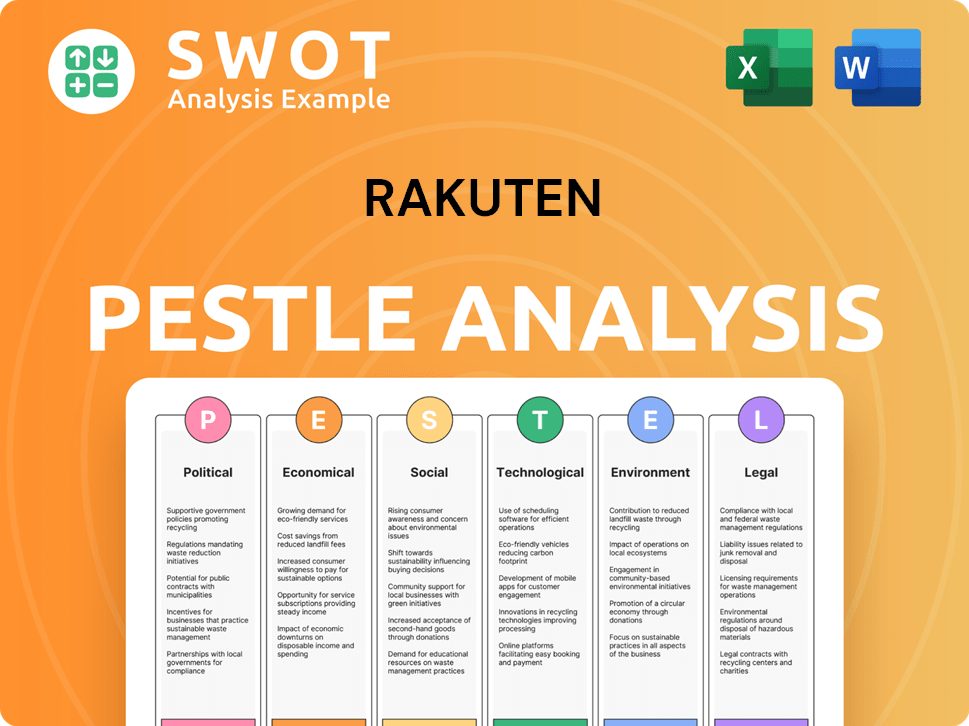
Which Strategic Decisions Have Shaped Rakuten’s Business Model?
The evolution of the Rakuten company has been marked by significant milestones and strategic initiatives that have shaped its operations and financial performance. These moves have been pivotal in defining how Rakuten operates and competes in the market. A key strategic move was the full-scale launch of Rakuten Mobile as a mobile network operator in April 2020, which has been a key driver for bringing new users into the broader Rakuten ecosystem.
Rakuten's journey has been characterized by both challenges and successes. While the mobile venture initially incurred substantial losses, it reached a significant milestone in December 2024 by achieving monthly EBITDA profitability for the first time. The company has consistently leveraged its integrated ecosystem as a core competitive advantage. This ecosystem, encompassing e-commerce, fintech, and mobile network services, fosters strong customer loyalty and cross-use of services.
The company has demonstrated adaptability in the face of challenges. Despite a net loss in FY2024, an improvement from the previous year, the company achieved consolidated profitability for the first time since FY2019. Rakuten's strategic partnerships and embrace of AI further reinforce its competitive edge in the dynamic market. These factors collectively contribute to Rakuten's ongoing evolution and its ability to navigate the complexities of the digital economy.
Rakuten Mobile achieved monthly EBITDA profitability for the first time in December 2024, recording 2.3 billion yen. Rakuten Mobile also achieved its first-ever profitable quarter in Q1 FY2025, with EBITDA reaching over 100 million yen (excluding property taxes). The Rakuten Super Points loyalty program issued over 4 trillion points as of 2024.
Rakuten Mobile's expansion is a key driver for bringing new users into the broader Rakuten ecosystem, with approximately 20% of mobile users being new to Rakuten. Rakuten plans to scale its AI foundation in 2025 and integrate AI into its services for improved efficiency and customer experience, including 'AI Omotenashi'. Rakuten Mobile plans to renew its roaming contract with KDDI beyond September 2026.
Rakuten's integrated ecosystem, encompassing e-commerce, fintech, and mobile network services, fosters strong customer loyalty and cross-use of services. The Rakuten Super Points loyalty program is a powerful asset, functioning as real currency across more than 70 services and encouraging repeat engagement. This integrated approach helps Rakuten differentiate itself from competitors like Amazon, whose ecosystem in Japan is narrower.
Despite a net loss of 162.4 billion yen in FY2024, an improvement from the previous year, the company achieved consolidated profitability for the first time since FY2019. In Q1 FY2025, while consolidated revenue increased, the company still faced a net income loss of 73.471 billion yen. EBITDA saw a significant rise of 51.4% to 79.9 billion yen in Q1 FY2025.
Rakuten's business model centers around its integrated ecosystem, which provides a wide range of services. This strategy aims to increase customer engagement and loyalty. The company's focus on innovation, including AI integration, supports its long-term growth and market competitiveness.
- E-commerce platform with diverse product offerings.
- Fintech services, including payment and financial products.
- Mobile network services to expand its ecosystem.
- Strategic partnerships to enhance service offerings.
Rakuten Business Model Canvas
- Complete 9-Block Business Model Canvas
- Effortlessly Communicate Your Business Strategy
- Investor-Ready BMC Format
- 100% Editable and Customizable
- Clear and Structured Layout
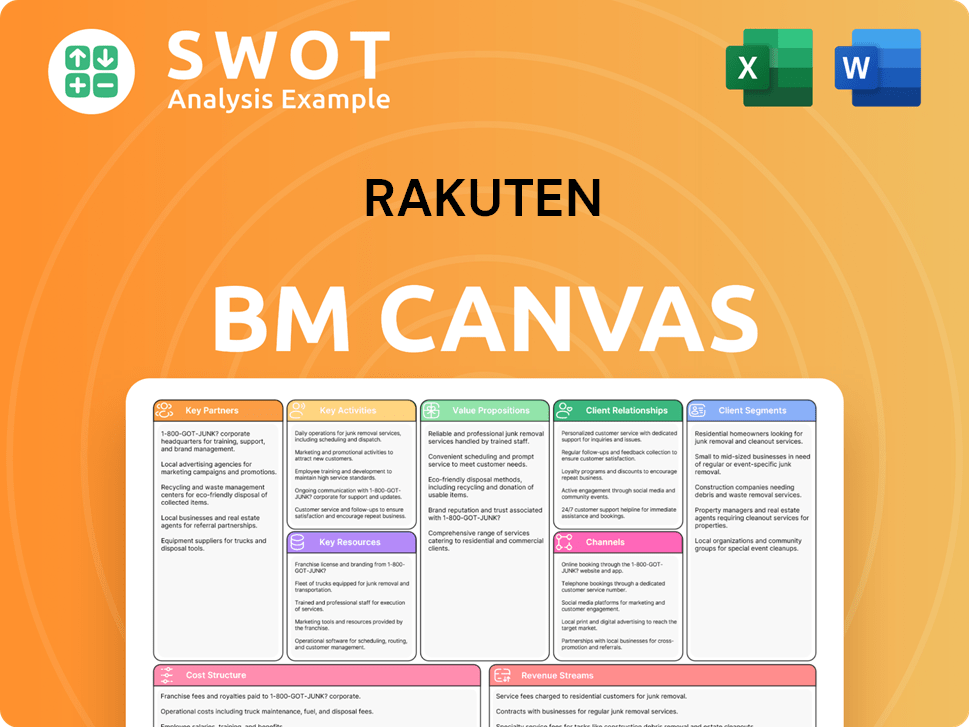
How Is Rakuten Positioning Itself for Continued Success?
The Rakuten company holds a strong position in Japan's e-commerce and fintech sectors, competing with major players. Its integrated ecosystem and the Rakuten Super Points loyalty program boost market share and customer loyalty. As of 2024, Rakuten has over 100 million members in Japan, demonstrating a solid domestic presence and integrated services.
Despite its strengths, Rakuten faces significant risks, particularly from heavy investments in its mobile business, leading to substantial debt. Ongoing capital expenditure for network expansion continues to impact liquidity. Furthermore, the company has reported net losses in recent periods, and faces competition in e-commerce and fintech.
Rakuten is a major player in Japan's e-commerce and fintech industries, competing with Amazon Japan and others. Its Rakuten Super Points program and integrated services help maintain customer loyalty. Over 70% of users interact with multiple Rakuten services, contributing to its robust industry standing.
Heavy investments in the mobile business have led to significant debt, with the debt-to-equity ratio exceeding 7 times in 2023. Continuous capital expenditure for network expansion impacts liquidity. The company reported a net loss of 162.4 billion yen for FY2024 and 73.471 billion yen in Q1 FY2025.
Rakuten aims to achieve profitability in its mobile segment and leverage its ecosystem for growth. Rakuten Mobile targets full-year EBITDA profitability in FY2025. The company plans to accelerate Group synergies and continue AI-nization initiatives to enhance efficiency. Analysts anticipate a substantial reduction in Rakuten Group's losses in 2025.
Rakuten plans to expand into new markets and enhance its technology capabilities, including using data analytics. Revenue projections for 2025 remain steady, with an anticipated 7% increase. These initiatives aim to sustain and expand its revenue generation and achieve long-term financial stability. To understand the competitive environment, check out the Competitors Landscape of Rakuten.
Rakuten's strategic focus includes achieving profitability in Rakuten Mobile and leveraging its ecosystem. The company's initiatives aim to drive domestic e-commerce growth and improve customer experience. The company's strategic initiatives, coupled with its robust ecosystem, aim to sustain and expand its ability to generate revenue and achieve long-term financial stability.
- Rakuten Mobile is targeting full-year EBITDA profitability in FY2025.
- Monthly EBITDA profitability achieved in December 2024.
- Quarterly EBITDA profitability achieved in Q1 FY2025.
- Analysts anticipate an 80% reduction in losses in 2025.
Rakuten Porter's Five Forces Analysis
- Covers All 5 Competitive Forces in Detail
- Structured for Consultants, Students, and Founders
- 100% Editable in Microsoft Word & Excel
- Instant Digital Download – Use Immediately
- Compatible with Mac & PC – Fully Unlocked
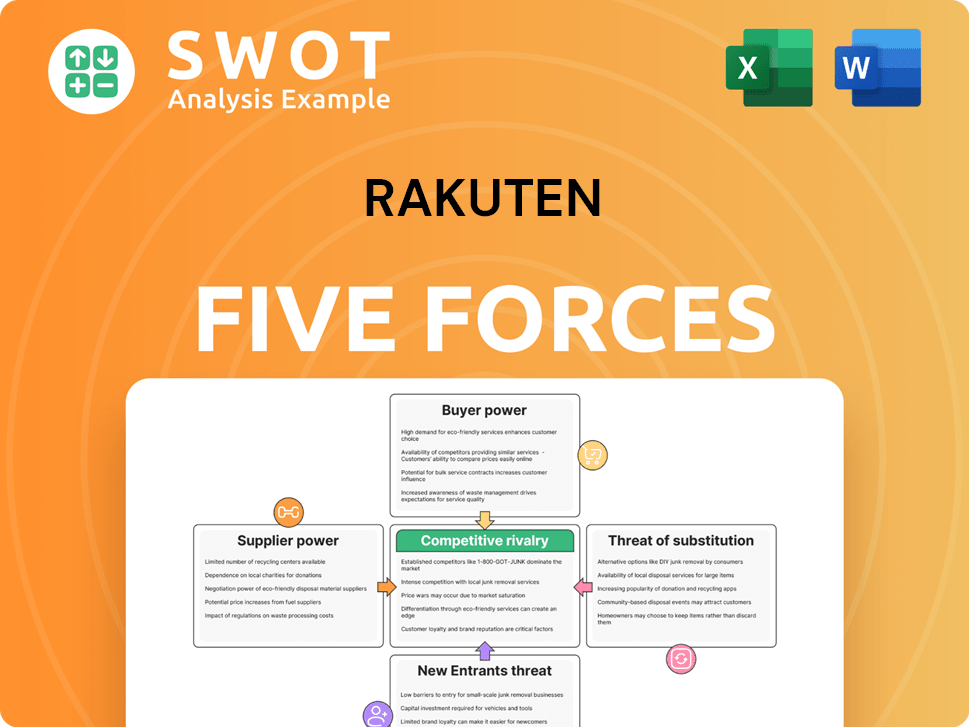
Related Blogs
- What are Mission Vision & Core Values of Rakuten Company?
- What is Competitive Landscape of Rakuten Company?
- What is Growth Strategy and Future Prospects of Rakuten Company?
- What is Sales and Marketing Strategy of Rakuten Company?
- What is Brief History of Rakuten Company?
- Who Owns Rakuten Company?
- What is Customer Demographics and Target Market of Rakuten Company?
Disclaimer
All information, articles, and product details provided on this website are for general informational and educational purposes only. We do not claim any ownership over, nor do we intend to infringe upon, any trademarks, copyrights, logos, brand names, or other intellectual property mentioned or depicted on this site. Such intellectual property remains the property of its respective owners, and any references here are made solely for identification or informational purposes, without implying any affiliation, endorsement, or partnership.
We make no representations or warranties, express or implied, regarding the accuracy, completeness, or suitability of any content or products presented. Nothing on this website should be construed as legal, tax, investment, financial, medical, or other professional advice. In addition, no part of this site—including articles or product references—constitutes a solicitation, recommendation, endorsement, advertisement, or offer to buy or sell any securities, franchises, or other financial instruments, particularly in jurisdictions where such activity would be unlawful.
All content is of a general nature and may not address the specific circumstances of any individual or entity. It is not a substitute for professional advice or services. Any actions you take based on the information provided here are strictly at your own risk. You accept full responsibility for any decisions or outcomes arising from your use of this website and agree to release us from any liability in connection with your use of, or reliance upon, the content or products found herein.